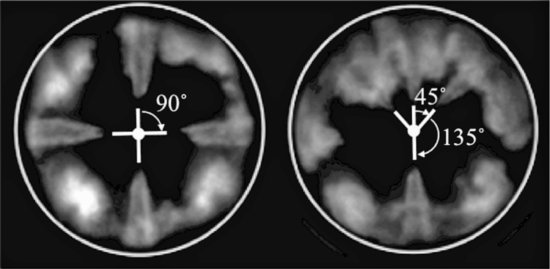10.3 Experiment 2: Lift-Off Length in a Diesel Engine
In a diesel engine, the flame is always found some distance from the fuel injection nozzle. This distance is called the lift-off length and, as explained in Example 5.1, it is useful for understanding trends in soot formation in such engines. The lift-off length is generally assumed to stabilize shortly after auto-ignition and remain stationary until the end of the fuel injection period.
Most investigations of how the lift-off length is affected by various parameters are conducted in spray chambers with optical access. These are typically large chambers where important conditions, like pressure and temperature, can be precisely controlled over wide ranges. This is obviously a great advantage from a data collection point of view, but a potential drawback is that spray chambers are not very similar to the combustion chambers of real diesel engines. Due to the limited volume in an engine's cylinder, the combustion inevitably increases both the temperature and pressure, but they remain relatively unaffected in a large spray chamber. Furthermore, to simplify measurements, spray chamber experiments are usually made with single-hole fuel injectors, while injectors in engines often have six to eight nozzle holes. Since spray chamber experiments ultimately are made to understand the processes in real engines, it is important to understand how these differences affect the lift-off length.
In contrast to spray chambers, optical engines maintain most of the features of real engines, making it possible to investigate the effects of the differences. In these engines, parts of the combustion chamber have been replaced with transparent parts. A drawback is that the optical parts put an upper limit to the in-cylinder pressures; this limit is often lower than those allowable in spray chambers.
Clément Chartier had found that lift-off lengths were often shorter in optical engines than in spray chambers. When experimenting with an eight-hole nozzle in an optical engine, he also discovered that the lift-off length did not stabilize during injection – it was constantly drifting towards the nozzle [3,4]. To understand the reason he used an empirical formula describing how the lift-off length is affected by various parameters, which was based on an extensive database of measurements with single-hole nozzles in a spray chamber. The formula clearly showed that the temperature of the air surrounding the fuel spray was a dominant factor.
Firstly, he calculated two interesting temperatures in the combustion chamber of his optical engine. One was the temperature of the fresh air that had not participated in combustion, the other was the mean temperature in the combustion chamber – an average including the temperatures in the flame, the burned gases and the fresh air. Then he used the empirical expression from the spray chamber “backwards”, to calculate the temperature required by this formula to yield the lift-off length he had measured. This temperature was substantially higher than the other two, indicating that the air surrounding the jet in the engine contained large amounts of hot, burned gases. An idea for an experiment started to form.
When injecting a single spray into a very large volume, mostly air is mixed into the spray close to the nozzle. For this reason the burned gases do not affect the lift-off length. In the engine, however, where several sprays are cramped into a much tighter space, it seemed like a substantial portion of the gas around each spray consisted of burned gases. This raised the question if the spacing between the sprays affected the lift-off length. Chartier decided to find out.
The hypothesis was that two burning sprays would constantly replenish the space between them with hot combustion products. This would gradually raise the temperature and push the lift-off closer to the nozzle. The smaller the inter-spray spacing, Chartier argued, the more the temperature would rise. To test this idea, he compared two different injector nozzles in the optical engine. One had four holes in a symmetric configuration, producing sprays that were at right angles to each other. The other also had four holes, but in an asymmetric configuration. One of the sprays was wedged in at 45-degree angles to its closest neighbors, whereas the opposite spray enjoyed a spacious 135 degrees to its companions. Figure 10.5 shows chemiluminescence images of the burning sprays taken with the two nozzle configurations in the engine. Keeping the number of holes and the total fuel flow rate constant in the two configurations allowed a direct comparison of the effect of the inter-spray spacing. This is important since changing the number of holes would have changed the amount of fuel injected per unit time, and thereby altered the temperature history in the cylinder.
Figure 10.5 Chemiluminescence images of burning fuel sprays in an optical diesel engine. Imaging takes place from the bottom, through the transparent piston. The nozzle is centrally positioned and the white circle indicates the boundary of the combustion chamber. Left: symmetric nozzle. Right: asymmetric nozzle. © Clément Chartier.

In addition to the inter-spray spacing, Chartier's experiment included other parameters that affect the lift-off length. It turned out that, in the optical engine, the effect of the air temperature was much weaker than spray chamber results indicated, and the inter-spray spacing actually had a stronger effect. Chartier attributed both these observations to the presence of hot, burned gases between the jets. It was also clear that the conditions varied between the combustion cycles in the engine, which resulted in substantial variability in the lift-off data. Such cycle-to-cycle variation is a well-known phenomenon in engines that is not accounted for in spray chambers, which are designed to produce extremely stable conditions.
Spray chambers are very valuable tools for understanding fundamental properties of sprays, but the results showed that one must proceed with caution when applying results from spray chambers to the analysis of real engines.
